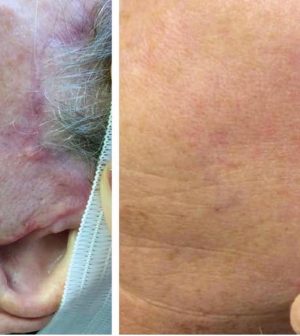- Could You Spot the Silent Symptoms of Stress?
- Gas Stoves Could Leave Your Lungs Vulnerable to Nitrogen Dioxide
- Key Therapy Equally Effective for Women, Men With Narrowed Leg Arteries
- Doctors Describe Texas Dairy Farm Worker’s Case of Bird Flu
- Does Preschool Boost Kids’ Long-Term Academic Success? Study Finds Mixed Results
- AI Might Spot Rare Diseases in Patients Years Earlier
- An Orangutan Healed Himself With Medicinal Plant
- Quit-Smoking Meds Not Working for You? Try Upping the Dose
- Fewer Americans Are Suffering Most Dangerous Form of Heart Attack
- Even Skipping Meat for One Meal Helps Liver Disease Patients
Microneedling Can Help Surgical Scars Fade, Especially If Done Early

A technique called microneedling may help surgical scars heal more attractively — especially if it’s done within a couple of months of surgery, a small study suggests.
Researchers found that for 25 patients, microneedling improved the long-term appearance of scars after various types of surgery — based on both patient and doctor ratings. But the sooner it was done, the better. Patients who underwent their first microneedling session within six or seven weeks of surgery had the best results.
That, the researchers said, goes against the “conventional wisdom,” which holds that microneedling should be delayed until scars are about a year old.
Microneedling is a layperson-friendly term for a procedure called minimally invasive percutaneous collagen induction, where doctors use a hand-held device outfitted with a tiny needle to create micro-punctures in the skin. The goal is to stimulate the skin’s natural repair mechanisms — including the production of collagen, a protein that helps the skin stay firm and smooth.
Dermatologists and plastic surgeons use microneedling to treat skin issues like wrinkles, stretch marks and scars from acne or surgical procedures.
When it comes to surgical scars, it’s known that they keep “maturing” for about a year, said Dr. Casey Sheck, one of the researchers on the new study.
“So a lot of [doctors] will say, let’s wait and see what this looks like then,” said Sheck, a surgeon with American Surgical Arts, in Mullica Hill, N.J.
But that means missing an opportunity to enhance the skin’s repair capacity, according to Dr. Brannon Claytor, the lead researcher on the work and chief of plastic surgery at Main Line Health, Claytor/Noone Plastic Surgery, in Bryn Mawr, Penn.
Around six weeks after surgery, Claytor said, surgical wounds are well along in the healing process. And he reasons that starting microneedling sessions around that time would not only be safe, but ultimately improve the scar’s appearance.
The current study is published in the September issue of the journal Plastic and Reconstructive Surgery. Claytor’s team enrolled 25 patients (all women) seeking treatment for scars from various types of surgery: facelifts, tummy tucks, breast surgery, and removal of non-cancerous skin growths among them.
All patients started their first of three microneedling sessions, along with a skin care regimen, within six to 16 weeks of their surgery.
Sixteen weeks after their first treatment, the study found, all patients were showing improvements in their scar — based on standard scales that measure both the doctor’s and patient’s ratings.
But on average, patients who started microneedling earlier — six to seven weeks after surgery — had a better scar appearance than patients who started treatment later (13 to 16 weeks after surgery).
“Early treatment of acute scars was safe,” Claytor said. “And the really exciting part was, we found evidence that it improved patients’ results.”
The study was small, the researchers acknowledged, and Sheck said the results offer a “proof of concept” that earlier is better.
But the findings came as no surprise to Dr. Kathleen Cook Suozzi, an assistant professor of dermatology at Yale School of Medicine, in New Haven, Conn.
“I typically see my patients one to two months after surgery for consideration of laser or microneedling treatments to improve scar appearance,” said Suozzi, who was not involved in the research.
At that point, she said, “I have a sense, from experience, which patients will benefit from early intervention with non-surgical scar treatments, like microneedling or laser, and which patients can continue” without these interventions.
Suozzi noted that this study had no comparison group whose scars were left to heal on their own. So it’s hard to know how much of the scar improvement was due to microneedling.
Still, Suozzi said, the comparison between patients who were treated earlier versus later “suggests that earlier intervention leads to better scar appearances sooner.”
For patients, Suozzi said, the key message is to talk with your doctor about all of the options for improving scar appearance.
“The best treatment for any one patient depends on many factors, including surgical site, type of surgical repair, patient age, and individual differences in healing,” she said.
Microneedling is generally safe, according to the American Academy of Dermatology — typically causing redness or other skin irritation for a few days.
But as with other procedures considered cosmetic, insurance typically does not cover it. According to device maker Dermapen, microneedling may cost anywhere from $100 to $700 per session, depending on the area of the body being treated.
More information
The Cleveland Clinic has more on microneedling.
SOURCES: R. Brannon Claytor, MD, chief, plastic surgery, Main Line Health, Claytor/Noone Plastic Surgery, Bryn Mawr, Penn.; Casey Gene Sheck, DO, surgeon, American Surgical Arts LLC, Mullica Hill, N.J.; Kathleen Cook Suozzi, MD, assistant professor, dermatology, Yale School of Medicine, and director, aesthetic dermatology program, Yale Medicine, New Haven, Conn.; Plastic and Reconstructive Surgery, September 2022
Source: HealthDay
Copyright © 2024 HealthDay. All rights reserved.










